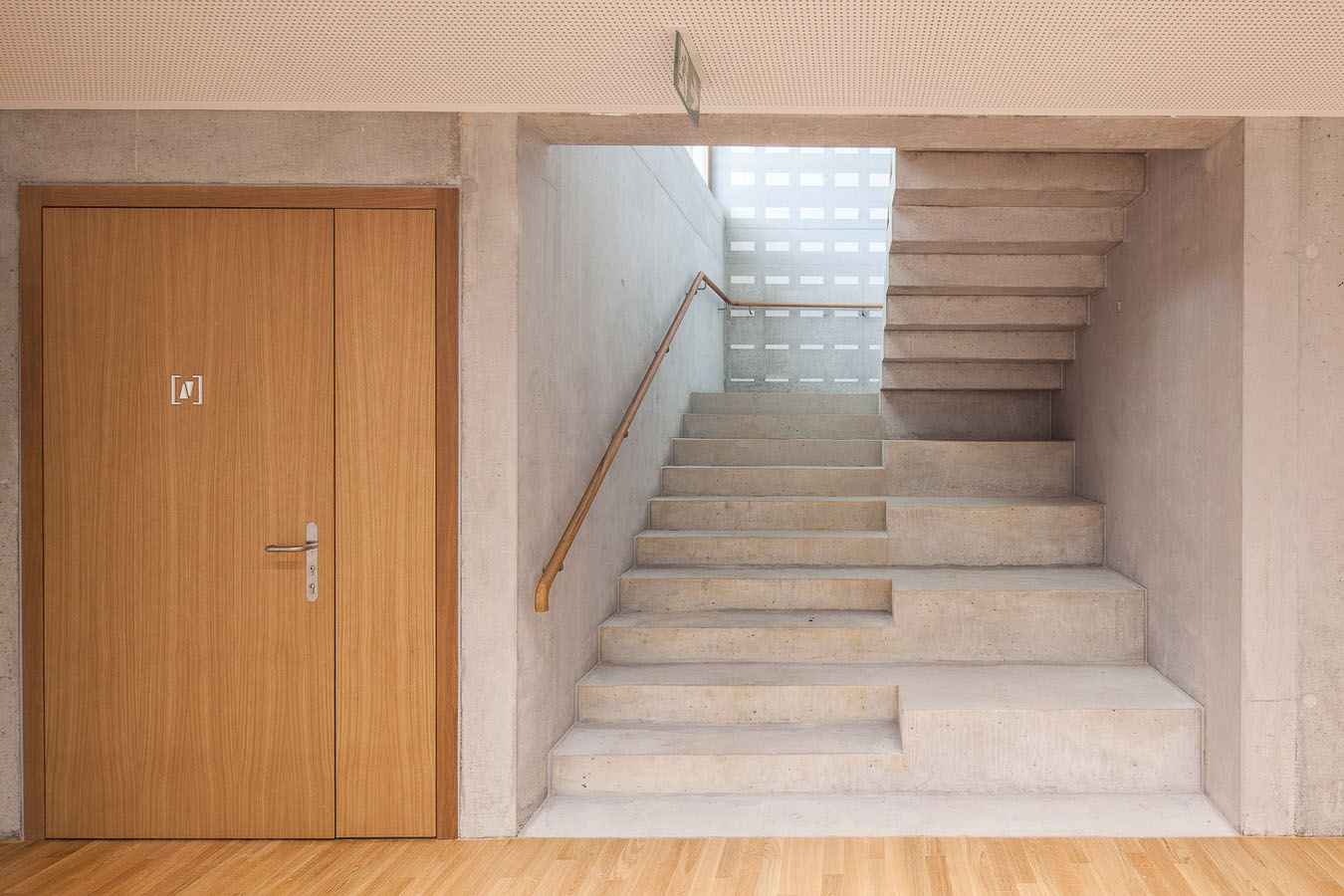Urban innovation for new Meinier school
Despite its tight urban site, the new school in Meinier, Switzerland, designed by Mue Atelier d’Architecture, succeeds in generating public space and establishing a rich dialogue with its surroundings due to its location. A building with a legible volume and benevolent character; a discovery…
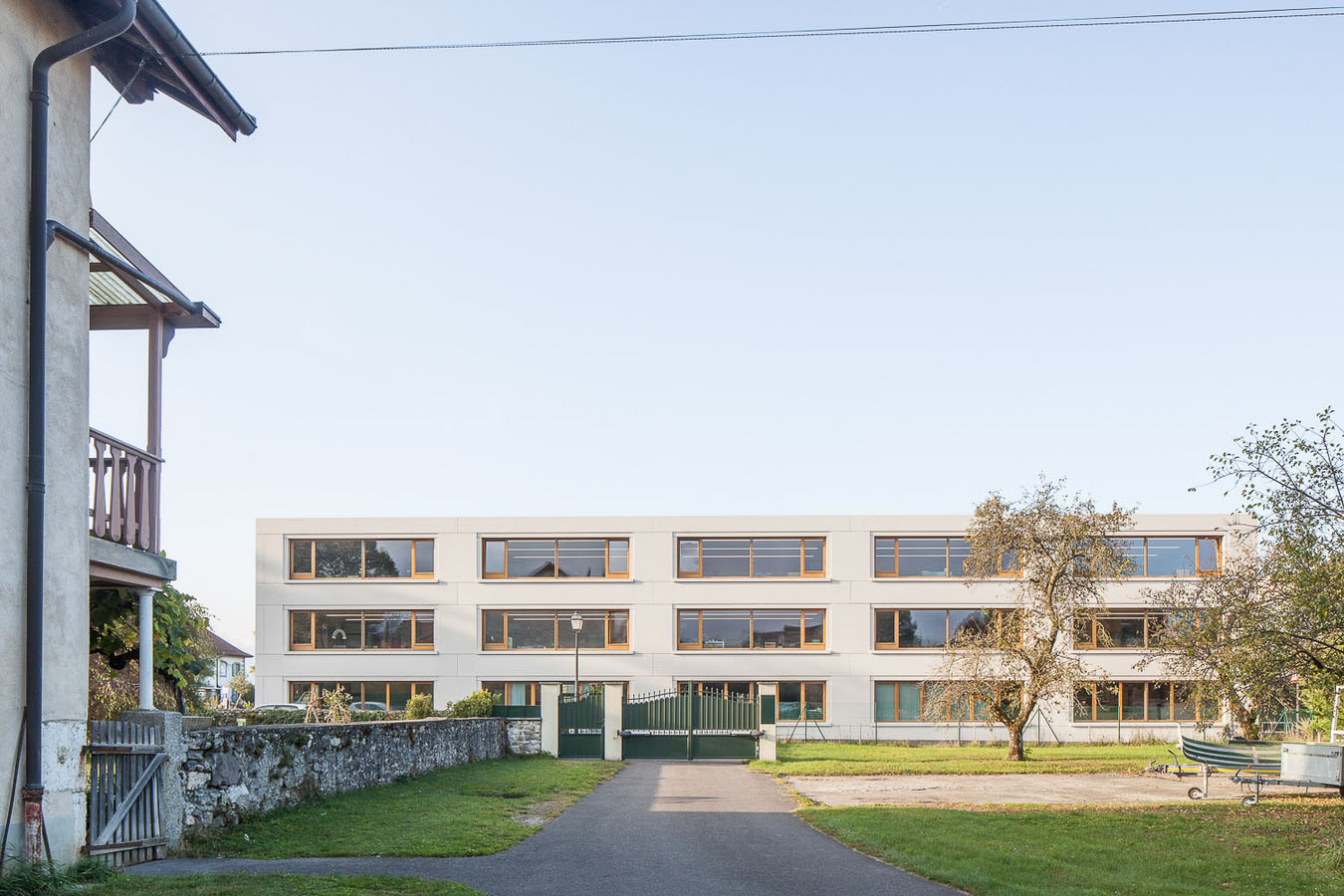
Photo: Arnaud Schelstraete.
School to regenerate town centre
The school programme groups together the nursery and primary school in response to a modest but steady increase in population within the municipality. In 2017, an open architectural competition proposed, in addition to a demolition project, the construction of a new school with ten classrooms, workshops and a physical education room. Among the 120 proposals, the jury was convinced by the insertion, rationality and sensitive attributes of the project designed by Mue Atelier d’Architecture.

Photo: Arnaud Schelstraete.
Build new place while enhancing town centre
Exemplary of development within the municipality, this new facility completes the renewal of the town centre. The uniqueness of the project lies in its ability to build a coherent school group around a covered courtyard, a development that creates a built link between the new school and two existing school buildings.
The compact architecture made it possible to extend the public space and establish links with existing green spaces, a transformation that is part of the town centre spatial continuity. The simple built volume is compatible with its built environment composed of isolated buildings with plastered facades, regular openings that provide a framework.

Photo: Arnaud Schelstraete.

Simple and compact volume, sensitive intervention, respectful contextual insertion
The school takes this vocabulary into account with its main facades clad in prefabricated concrete panels with a specified granular composition. The bush-hammered frames contrast with the sandblasted finish of the main elements to emphasise the openings and oak joinery.
The appropriate distances between buildings, the adapted proportions, materials and construction details generate a beautiful spatiality and give the structure its welcoming character. Volumetric legibility is expressed in the design of the facility – all classrooms are located on the upper floors. North orientated, they enjoy uniform daylight and are protected during heatwaves. The distribution over the entire length of the building provides a generous and bright space, easily appropriated by its users.
Linked directly to the courtyard, the ground floor is planned on the same principle – the lobby provides access to the administration, extracurricular facilities and educational workshops overlooking the street. A monumental staircase gives access to the upstairs classrooms and the basement, where plant rooms and storerooms are located.
Natural, durable materials, fit for purpose – terrazzo, timber, concrete – confer a warm softness to the interior design.

Plan RDC (Rez-de-chaussée) / Street level plan.


School group unified around courtyard
An energy-independent building implies simplicity in its use and maintenance. Orientation, built volume and a high-performance envelope are the primary criteria that reduce its energy consumption. The externally insulated envelope and concrete structure provide high thermal inertia. Energy production is provided by a heat pump together with a rooftop photovoltaic solar energy unit. A simple natural ventilation system operated by users was chosen. All of these parameters underscore the environmental quality of the Meinier school extension.

Photo: Arnaud Schelstraete.


Ecole primaire de Meinier, Suisse
La nouvelle école de Meinier, en Suisse, réalisée par l’atelier Mue, parvient par son implantation à générer de l’espace public et à établir un riche dialogue avec son environnement. Un ouvrage au volume lisible et au caractère bienveillant.
Le programme de l’école maternelle et primaire répond à l’accroissement modéré mais constant de la population de la commune. En 2017, un concours d’architecture en procédure ouverte propose, outre un projet de démolition, la construction d’une nouvelle école comptant dix salles de classes, des ateliers et une salle de motricité. Parmi 120 propositions, le jury est convaincu par l’insertion, la rationalité et les qualités sensibles du projet conçu par l’atelier Mue.
Emblématique du développement de la commune, le nouvel équipement parachève l’opération de restructuration du centre-bourg. La singularité du projet réside dans sa capacité à édifier un groupe scolaire cohérent autour d’un préau couvert, une intervention créant un lien construit entre la nouvelle école et deux bâtiments scolaires existants.

Photo: Arnaud Schelstraete.
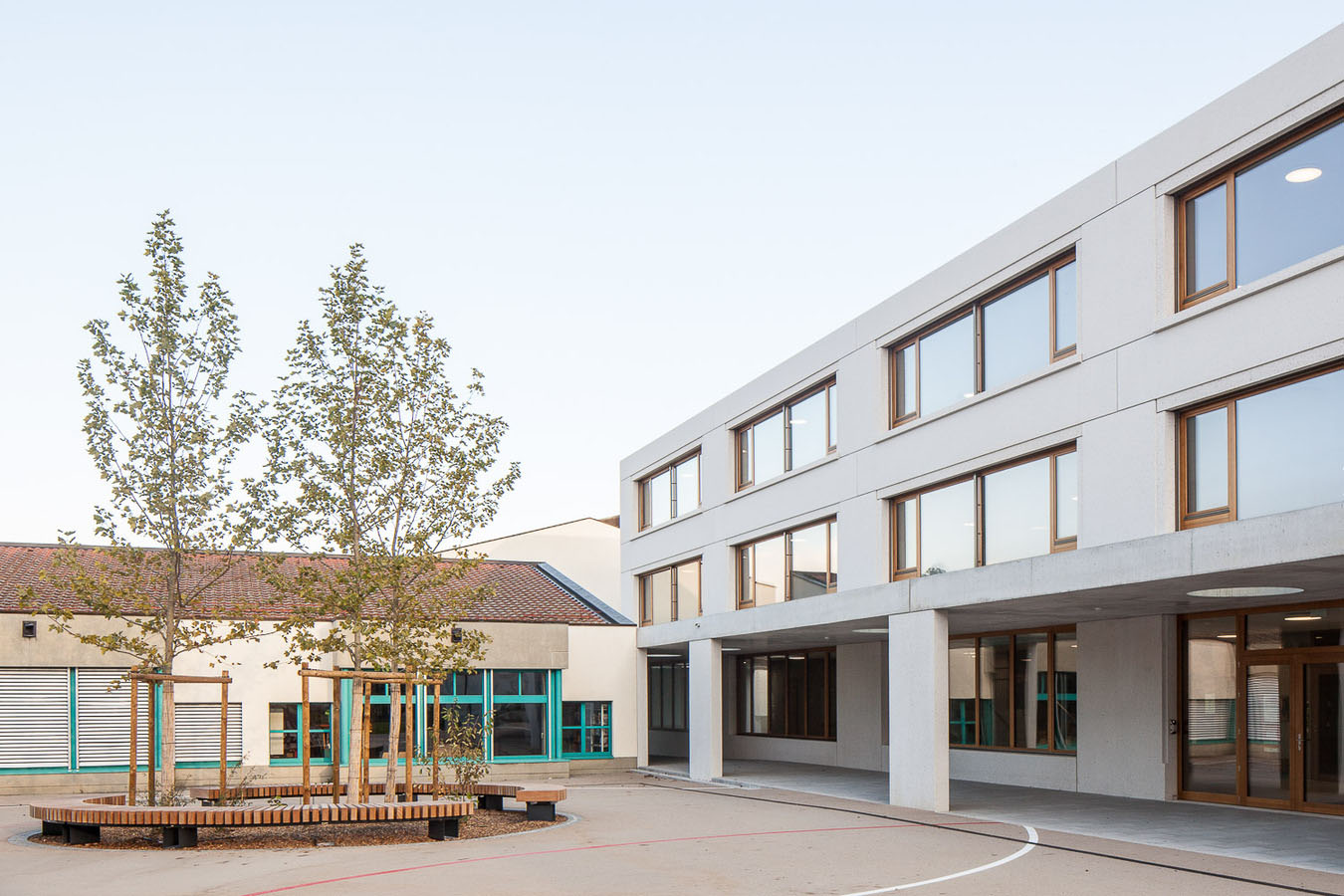

L’architecture compacte de l’ouvrage a permis de dilater l’espace public et d’établir des porosités avec les espaces verts existants, une transformation inscrite dans la continuité spatiale du coeur de ville. La volumétrie simple de l’ouvrage est en cohérence avec le bâti environnant, constitué de bâtiments isolés aux façades enduites dont les percements réguliers proposent généralement un travail d’encadrement.
L’école reprend ce vocabulaire à son compte avec ses façades principales vêtues de panneaux de béton préfabriqué à la composition granulométrique spécifique. La finition bouchardée des encadrements contraste avec la finition sablée des parties courantes, soulignant ainsi les percements et les menuiseries en chêne.
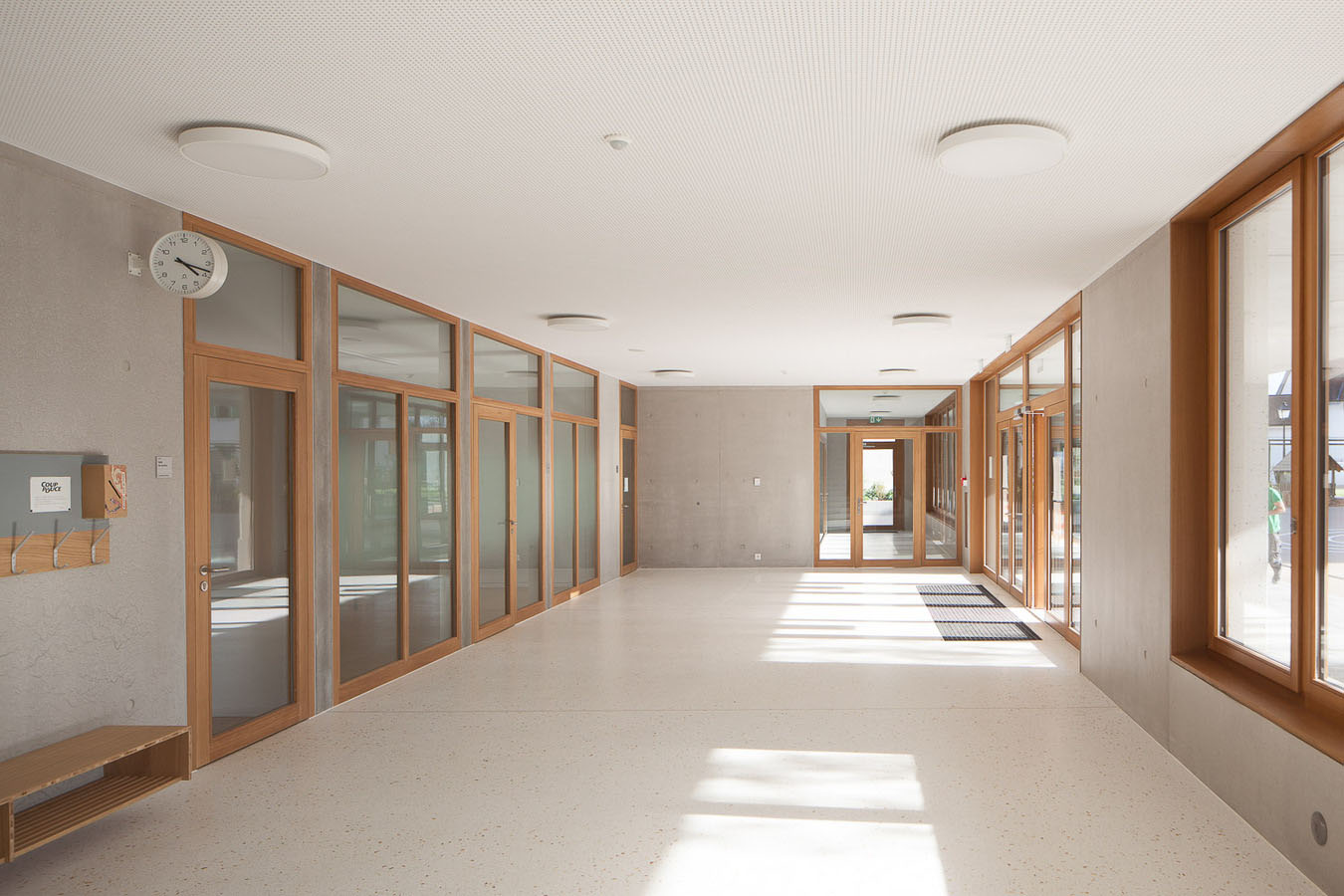
Photo: Arnaud Schelstraete.

Les justes distances entre les constructions, les proportions ajustées, les matériaux et les détails de leur mise en oeuvre génèrent une belle spatialité et donne à l’ouvrage son caractère accueillant. La lisibilité du volume se retrouve dans le fonctionnement de l’équipement, le parti pris étant d’organiser l’ensemble des salles de classes aux étages. Orientées au nord, elles bénéficient d’une lumière homogène et d’une position favorable lors des périodes de forte chaleur. La distribution sur toute la longueur du bâtiment offre un espace généreux et lumineux, facilement appropriable par les usagers.
Le rez-de-chaussée, en lien direct avec le préau, est organisé selon le même principe : le hall distribue l’administration, les locaux parascolaires et les ateliers pédagogiques donnant sur la rue. Un escalier monumental donne accès aux dix classes en étage et au sous-sol, où sont concentrés les locaux techniques et dépôts communaux.

Photo: Arnaud Schelstraete.
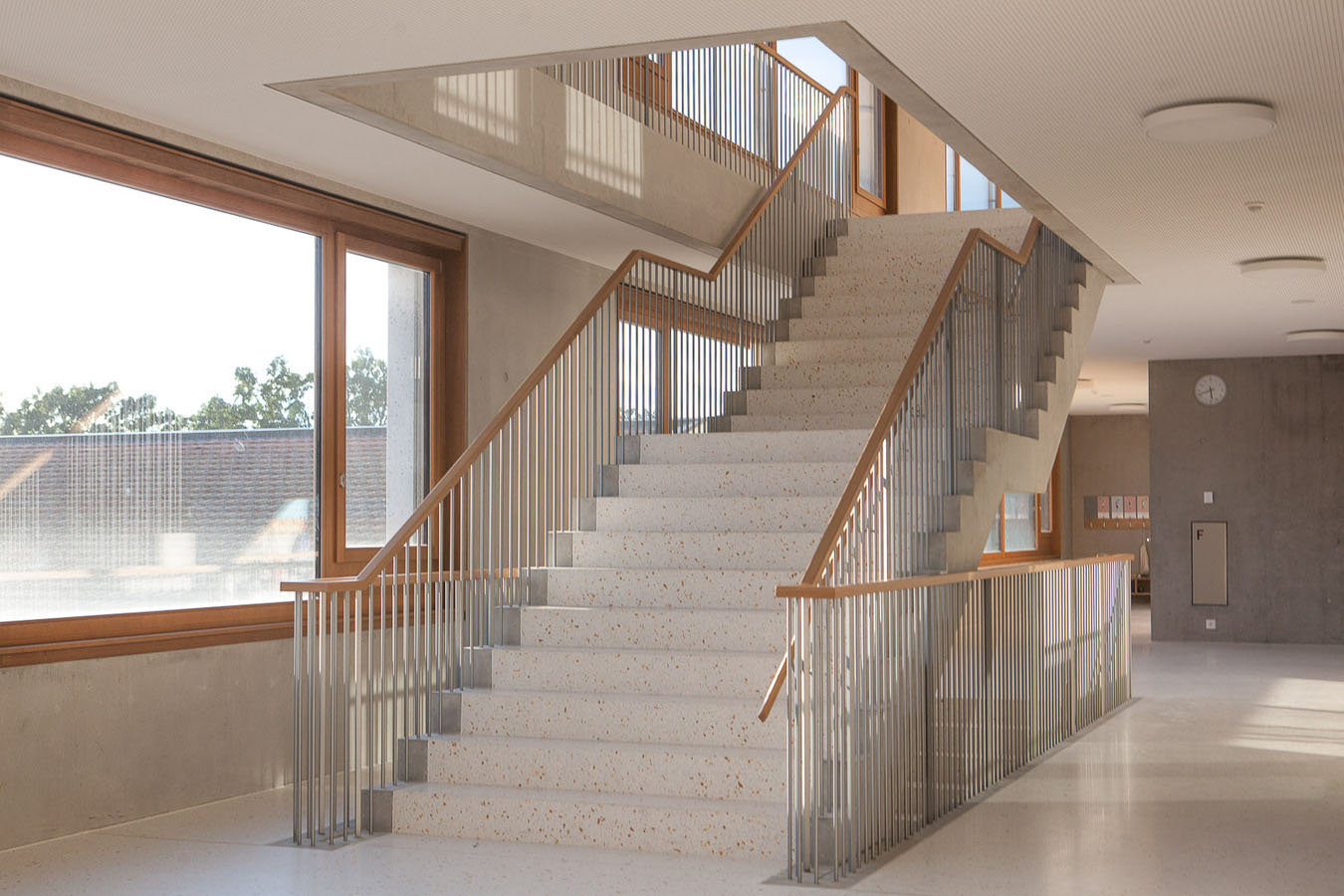

Des matériaux naturels, pérennes et adaptés aux usages – terrazo, bois, béton – confèrent à l’aménagement intérieur une douceur chaleureuse.
Un bâtiment autonome en énergie implique une simplification dans ses usages et sa maintenance. L’orientation, le rapport de forme et une enveloppe performante sont les critères premiers limitant sa consommation énergétique. Ainsi, l’enveloppe isolée en continu par l’extérieur et la structure béton offrent une forte inertie thermique. La production énergétique repose sur une pompe à chaleur combinée avec une centrale solaire photovoltaïque en toiture. Une ventilation naturelle contrôlée simplement par les usagers a été privilégiée. L’ensemble de ces paramètres témoignent de la qualité environnementale de l’extension de l’école de Meinier.

Photo: Arnaud Schelstraete.
